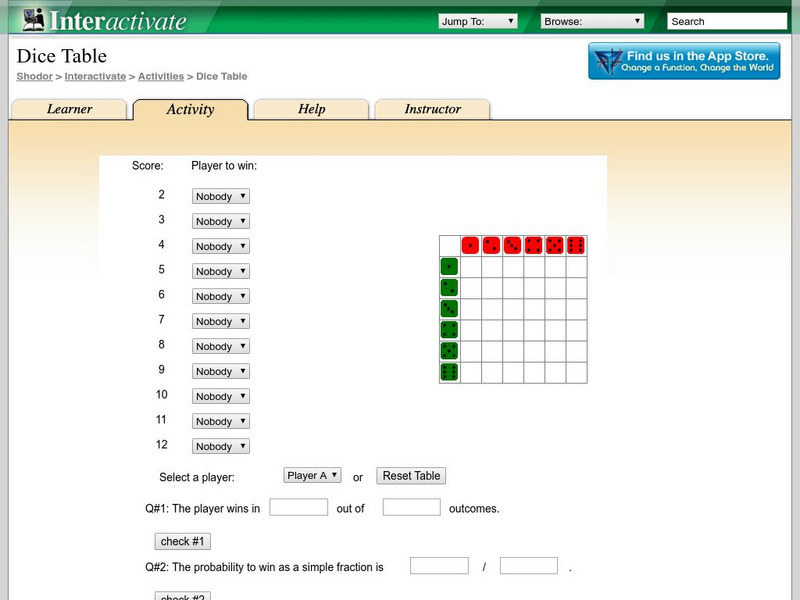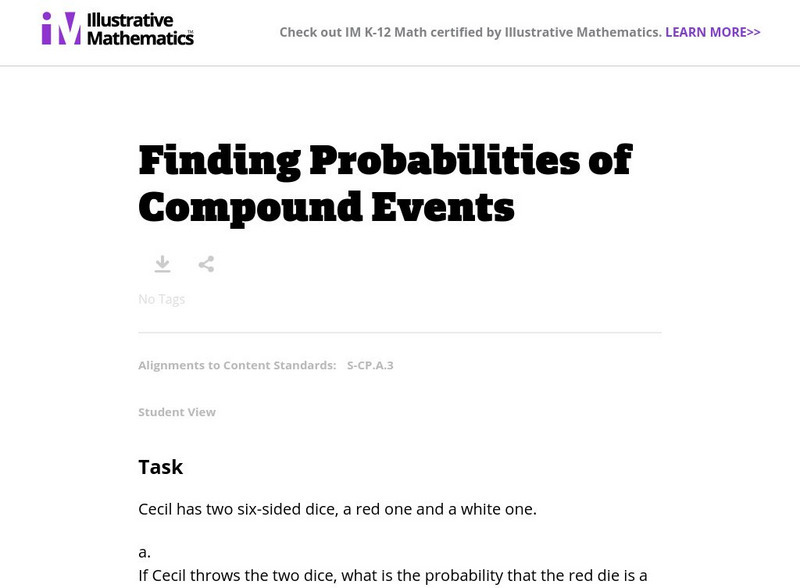Hi, what do you want to do?
Curated OER
Probability Plus
Learners participate in a variety of activities to understand statistics. They collect and interpret data. Also students distinguish the difference between a population and a sample. They make inferences and create arguments using data.
PBS
Remove One
With a set of 15 chips and a number line, learners predict what sums may occur with the rolling of two dice. When their sum comes up, they remove one of the chips from their number line with the objective of being the first to remove...
EngageNY
Expected Value of a Discrete Random Variable
Discover how to calculate the expected value of a random variable. In the seventh installment of a 21-part module, young mathematicians develop the formula for expected value. They connect this concept the dot product of vectors.
Curated OER
What's the Matter? Locating Electrons in an Atom
Students roll dice in order to simulate the probability of locating an electron in a certain region around the nucleus.
Curated OER
Dominoes
Fourth graders solve a dominoes word problem, calculating all the possible outcomes for a sequence of events. They discuss the problem, apply counting strategies, create a tree diagram, and write an explanation of how they solved the...
Curated OER
Roll `Em!
First graders engage in using base ten blocks and dice for a fun engaging math lesson. They use a worksheet imbedded in this lesson as the game board to help them play this math game.
Curated OER
Unexpected Answers
Students consider probability problems with unexpected and surprising answers.
Curated OER
What Are the Risks?
Middle schoolers use dice to determine the risk of being exposed to radon. They practice using new vocabulary related to probability and ratios. They make predictions about the results and record their observations.
Curated OER
What's Ponytail's Big News?
Students discuss reasons to not smoke. In this anti-smoking lesson plan, students listen to a story where the character Ponytail the pony doesn't smoke and is thus able to engage in physical activities. They create Ponytail's pinwheel...
Curated OER
Rules of Sign Change
Young scholars manipulate negative and positive numbers. In this integers lesson, students move through three activities exploring negative and positive whole numbers. A number line, cardboard function representation, and solving...
Curated OER
Thanksgiving: Traditions
Young scholars investigate the traditions and history around Thanksgiving. They divide into groups and research specific aspects of the holiday. Students then share their findings with the rest of the class. They also complete crafts,...
Curated OER
The Fair Factor
Students participate in playing many games to determine if they are fair or not. They create their own game that is fair to play with their classmates.
Curated OER
Number Sense
Eighth graders participate in a lesson that is concerned with reviewing basic math concepts using the four operations. The activity is composed of a math game that is played by them.
PBS
Pbs Mathline: Remove One Lesson Plan [Pdf]
Students play a game involving chips, dice, and a number line to explore the outcomes of events. Printable lesson.
University of Texas at Austin
Mathematics Teks Toolkit: Rolling Races
Students play a game by rolling dice and determining the probability of outcomes of colors.
Shodor Education Foundation
Shodor Interactivate: Dice Table
A dice-table activity introduces students to probability and to converting probability to a simple fraction, a decimal, and a percentage.
Illustrative Mathematics
Illustrative Mathematics: 7.sp Rolling Dice
Roll two dice 10 times. After each roll, note whether any sixes were observed and record your results in the table below. Aligns with 7.SP.C.7.
Illustrative Mathematics
Illustrative Mathematics: S cp.a.3: Finding Probabilities of Compound Events
Cecil has two six-sided dice, a red one and a white one. Aligns with S-CP.A.3.
Illustrative Mathematics
Illustrative Mathematics: 7.sp.8 Tetrahedral Dice
Many games use dice which are six-sided and fair (meaning each face on the die is equally likely to land face up). Many games also use the sum of two dice rolled at the same time to determine movement of game pieces. However, not all...
Other popular searches
- Probability and Dice
- Probability and Dice Graph
- Probability Dice and Cards
- Probability Dice and Coin


















![Pbs Mathline: Remove One Lesson Plan [Pdf] Lesson Plan Pbs Mathline: Remove One Lesson Plan [Pdf] Lesson Plan](https://static.lp.lexp.cloud/images/attachment_defaults/resource/large/FPO-knovation.png)

